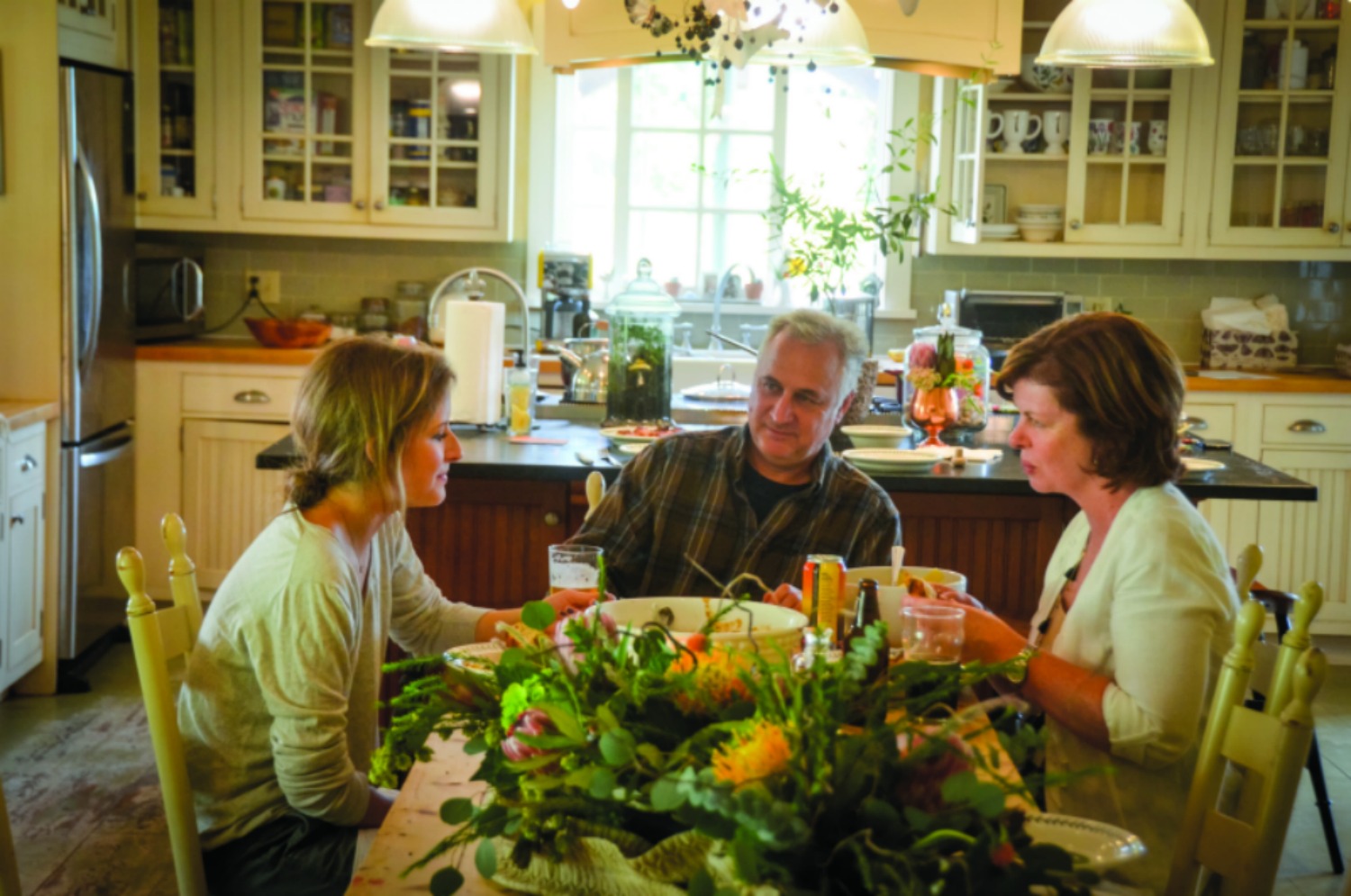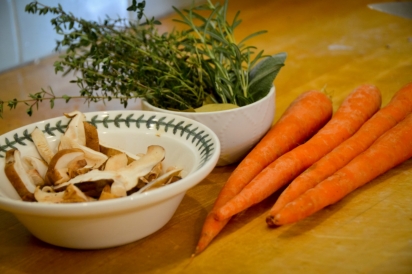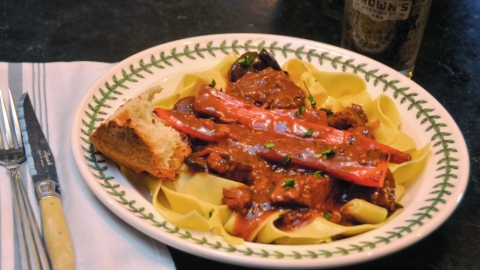Kelly and Garry Brown
A blackened cast-iron skillet presides atop Kelly Brown's six-burner range, caked with 20 years of lovin’. “I use it every day, wipe it out with a paper towel, and it’s ready to go.” From thick-cut bacon in the morning to browning onions and beef come dinner, Kelly lives the locavore’s dream. Her gardens burst with veggies, herbs and fruit; her freezer is filled with chicken, pork and beef from local farms. “We just joined Clear Brook Farm’s winter CSA, and Beatrice Berle lives right around the corner in East Hoosick. She’s been a good friend for years, and her beef and dairy are amazing. Things taste better when you source as local as possible, and for us, quality is everything.”
Well suited to run Brown’s Brewing Company together since 1990, Kelly and Garry Brown remain committed to supporting local farms in their beer, their taprooms and their home kitchen.
“I do all the cooking for the family,” Kelly says. “Garry has many amazing talents, but cooking isn’t one of them. He does thank me for every meal, though, and he cleans up afterward.” Garry quips, “Beats having to track down a squirrel and skin it.”
“I’m always inspired by what I find at farmers’ markets or farm stands. I love Alice Waters’s approach of best-quality ingredients and simplicity. This fall, I made a ratatouille with white eggplant. I also make a rice and corn dish in the summer,” Kelly continues. “I use Moses Farm sweet corn, Vidalia onion, cooked rice, a little sugar and some chopped mint.” Garry’s favorite? “Eggplant Parm.” And daughter Nora? “Definitely Mom’s onion rings.”
Kelly grew up in Saratoga Springs and Garry hails from Schenectady. The couple always dreamed of having a small farm in the country. Wandering the 110-acre property in West Hoosick, it’s clear that the Browns achieved their vision. “This had been a small dairy and chicken farm, and the original part of the house dates to the 1790s,” explains Garry. “We’ve spent about 20 years on renovations, but it’s been a great place to raise our three girls—Abby, Nora and Maggie.”
The hills and pastures above the house and barn offer trails for hiking and riding the family’s horses. Garry loves his tractor time, and Kelly mucks the stalls and tends her extensive gardens. Laying hens keep the family supplied with eggs and take care of kitchen veggie scraps. There’s talk of raising a couple of Tamworth pigs again.
The house is ideally designed for entertaining, with the kitchen flowing into the dining room. “When we moved in, there were no windows on the west side,” Garry says. “So we built a three-season room off the kitchen and that’s where we hang out.” Perhaps that explains the 1960s refrigerator with Brown’s Brewing stickers affixed on the door....
“At the holidays, this house becomes the family hub,” Kelly says. “We’re fortunate that our parents live nearby in Saratoga and Sche- nectady. All the aunts, uncles and cousins come over, filling the table and the island.”
“We bought things as we could afford them,” she continues. “My kitchen for years was plywood and Garry cobbled together a stove top. But I still loved to cook anyways and made it work!” Patience paid off and Kelly now revels in her soapstone countertops and Wolf range with double ovens.
After two decades, the Browns had a neighbor build a proper dry stone wall in front of the house. “Every stone came from our fields,” Garry notes proudly. Contoured to flow with the land and stately ma- ple trees, the wall looks like it has been there since the 18th century.
Kelly’s gardens reflect both her artistry and sensibility. From spring through fall, she nurtures a multitude of herbs and vegetables and a profusion of annuals and perennials. Equally inviting are the pergola with climbing hops (of course!) and strands of white lights, rock walls and steps, and sturdy trellises made from leftover barn timbers.
And though he may not cook, Garry does brew some mean beer. Over a plate of beef stew braised slowly in Brown’s Oatmeal Stout (the brewery’s flagship beer) and served with egg noodles, Garry shares the story of the brewery’s steady growth.
“I started as a 1980s home brewer and kept my eyes on the West Coast as the craft beer scene emerged. We bought the building on River Street in Troy in 1990 and opened our doors in February 1993. We were the first brew pub in the Capital District. Our first beer brewed on a commercial scale was a porter. I still say it’s one of the best beers we produce.”
“Troy has become the R&D facility,” Garry explains. “We have two young brewers who are living the dream, making beer, playing with new styles and recipes. Burst, our new Valencia orange IPA, was one of their initiatives. The basement in Troy is filled with wine and bourbon barrels, and these guys are blending new flavors, inoculating beers with different bacteria. We’re making at least 40 different styles of beer, and with 14 to 16 taps going, the taprooms allow us to see what the patrons like.”
The Browns opened the Walloomsac Taproom and brewery in North Hoosick in 2013. Troy is the test kitchen; production and packaging occur in Hoosick. “Burst is our first step into canning,” Garry says. “It will hit the streets after the first of the year. Right now it’s only available for sale in cans and only from our taprooms. We plan on canning the Oatmeal Stout, Cherry Raspberry Ale and another great IPA. They’ll all have a variation on the gradient color theme, which will distinguish them on the shelves.”
“We have two talented chefs at the taprooms—Melissa Sheridan in Troy and Anthony Taurone in Hoosick,” Kelly adds. “We purchase produce from Clear Brook Farm and Happenchance Farm, sweet corn and pumpkins from Moses Farm, eggs from Cornell Farm, beef from Tiashoke Farm and Berleberg cheese from Berle Farm. The hops for our Harvest IPA come from Hop Hollar Farm.”
“While Troy has traditional pub fare, the Walloomsac Taproom allows us to experiment a bit more because it’s new,” Garry says. “We built a wood-fired grill, and a neighbor brings pallets of wood to feed the grill.”
Garry and Kelly’s five-year plan for North Hoosick involves estab- lishing both a malting facility and hop-processing facility to support local grain and hop producers. New York had been the largest hop producer in the country until Prohibition. “If we can buy direct from local farmers and process ingredients here,” Garry says, “then we can have a New York State beer through and through.”
“We’re so grateful for our team of innovative, creative people,” Kelly says. “And we don’t take shortcuts. For example, when we brew the Pumpkin Ale in late September, we bring in truckloads of ripe pumpkins from Moses Farm and cook them down.”
“We put in the hours and go the extra mile because we feel passionate about what’s in the bottle, the can, the glass,” Garry concludes. “The product has our family name on the label. That says it all.”







